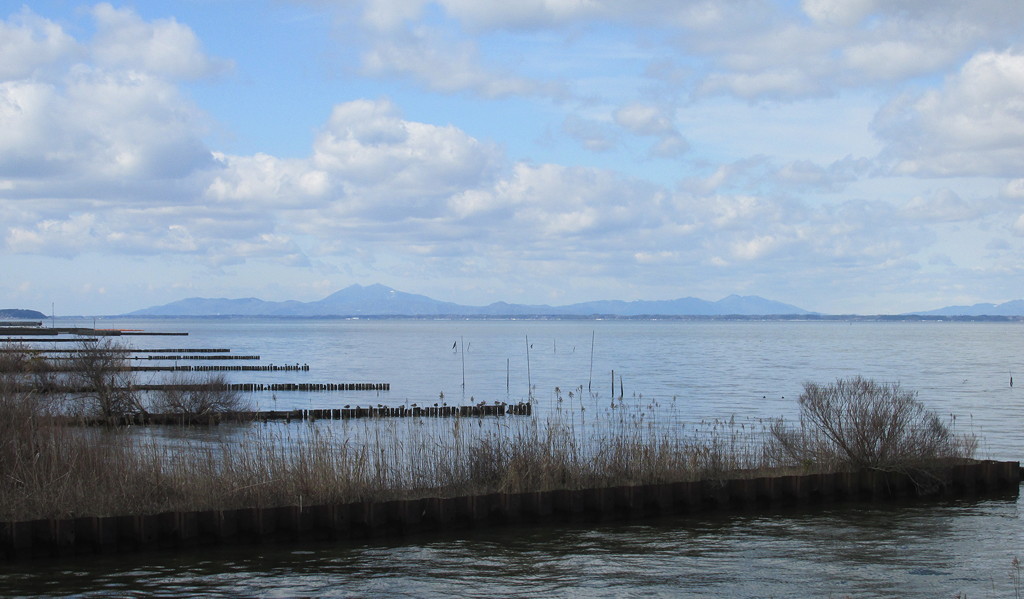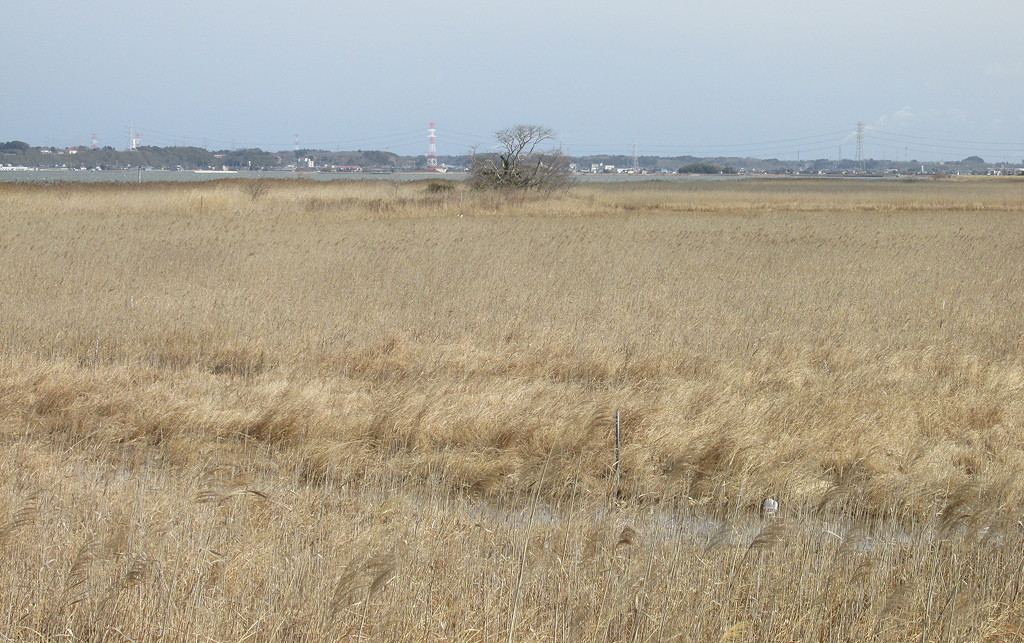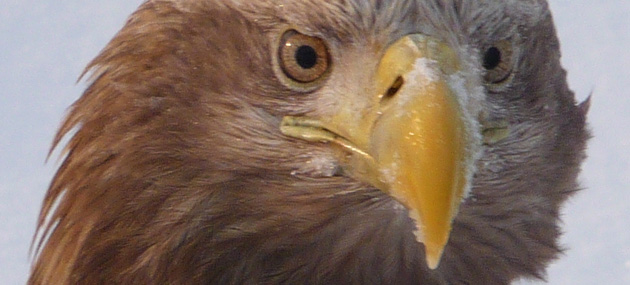Two species near Narita Airport – Marsh Grassbird (Japanese Marsh Warbler) and Japanese Reed Bunting (Ochre-rumped Bunting) are, in the spring and early summer, easy to see in suitable habitat.
 One place is Ukishima, on the southeast side of Lake Kasumigaura in Ibaraki Prefecture, and the other site is along the Tone River near Sasagawa in Chiba Prefecture.
One place is Ukishima, on the southeast side of Lake Kasumigaura in Ibaraki Prefecture, and the other site is along the Tone River near Sasagawa in Chiba Prefecture.
Ibaraki Prefecture Lake Kasumigaura/Ukishima 茨城県 霞ヶ浦 浮島
For birders, winter at Ukishima means one thing: watching harriers fly in to roost late in the afternoon.
The viewing area overlooking the large reedbed adjacent to Lake Kasumigaura is a popular spot for photographers and birders waiting to see Eastern Marsh Harrier and Hen Harrier as they fly in to roost, as well as Merlin. Twenty or more harriers (mostly Eastern Marsh Harrier) may assemble during the late afternoon, when they circle low over the tops of the reeds and perch on trees and bushes before dropping into the middle of the reeds to roost.
There are usually one or two Hen Harrier, too, and Merlin often can be seen zipping low and fast over the reeds before quickly dropping down to roost.
During the winter Eurasian Bittern is present, as are Brown-cheeked Rail and Common Snipe.
In late spring and early summer this is a good spot to watch for Marsh Grassbird and Japanese Reed Bunting. Although they are both resident here, outside of the breeding season they are much harder to locate as they spend a lot of time feeding down around the bases of the reeds, whereas in sring and summer they often visit the reed tops when singing or displaying.
Oriental Reed Warbler and Zitting Cisticola are also present in good numbers during the breeding season. Soon after the reed warblers arrive and begin singing it can be difficult to actually hear any other species due to the amount of noise the reed warblers make! They are loud!
On nearby Lake Kasumigaura, apart from the ubiquitous Great Cormorant and a few Osprey, large numbers of ducks can be found during the winter. Northern Pintail, Mallard, Eurasian Wigeon, Eurasian Teal and Spot-billed Duck are especially common.
Among the flocks look for Falcated Duck and Baikal Teal which are often present. Diving ducks include Common Pochard, Tufted Duck and, usually, a few Smew.
In farmland around the lake look for Green Pheasant as well as Bull-headed Shrike and Meadow Bunting.
During the spring migration season (late April until mid-May), it is worth exploring the area of lotus fields and rice paddies in the area for shorebirds. Several species, often in stunning summer plumage, drop by to feed before heading to their breeding grounds in the high Arctic. These include Bar-tailed Godwit, Grey Plover, Pacific Golden Plover, Grey-tailed Tattler, Ruddy Turnstone and Red-necked Stint.
Rare or unusual birds that have been seen in the area include Ruddy Shelduck, Stilt Sandpiper, Long-billed Dowitcher (annual during winter) and Latham's Snipe (annual in early autumn). Ukishima used to be a regular site for Schrenk's Bittern.
Access:
It is difficult to reach Ukishima without a vehicle as there are no bus stops or train stations nearby. The nearest station, Sawara, on the Narita Line from JR Narita Station, is about 9 km away. Itako Station, on the Kashima Line, is another possibility. Taxis are available outside the stations (the one-way charge is about ¥3,500).
Rental bicycles (¥1,000 per bike) are available from the tourist office (09:30–1700 only).
Ukishima car park and toilets Map 35.961139, 140.458128
Rice paddies/lotus pond area for shorebirds: Map 35.968681, 140.418942

Tone River (Tonegawa) and Sasa River (Sasagawa) 千葉県利根川/笹川駅近く
For those who do not have access to a vehicle, an easier way is to go to Sasagawa Station and walk to the Tone River. Use the Narita line from Narita Station, and take a train going in the direction of Choshi. It will take about 45 minutes from Narita Station to Sasagawa Station.
From Sasagawa Station, walk out of the exit and go straight for about 15-20 minutes, in a northerly direction (209 to Route 356, which goes east-west, then 266 to the Kurobe River) until you get to the river bank. Here, just after a cement factory on the left hand side, 266 crosses the Kurobe River, makes a sharp left turn, and goes into another section of 356. At this bend the wide Tone River is directly in front of you. To your right is an inlet with several small pleasure boats and a concrete lock gate.
From this corner, going east and over the lock which connects the Tone River inlet to the narrow Kurobe River, is a road at a higher elevation than the rice paddies on the right and the reeds and Tone River on the left (the road is built on the raised embankment on the south side of the river).
Walk along this road (going downstream, in the direction of Choshi) for a couple of kilometers, until you come to a rest area with a shelter and wooden viewing area. Marsh Grassbird is quite common all along the side of the river, and in April and May the males can be seen making their display flights above the reeds before dropping back down.
There are also several pairs of Japanese Reed Bunting along the way, and other species include Oriental Reed Warbler, Zitting Cisticola, Masked Bunting, and Meadow Bunting, as well as Great White, Intermediate and Little Egret. Waders such as Whimbrel, Ruddy Turnstone, and Grey-tailed Tattler can be found in the rice paddies as they migrate north during April and May, and there are probably Greater Painted Snipe there, too.
To return to Sasagawa Station, retrace your steps to the corner at Route 209, and turn left, and walk straight back to the station. If you have time, walk upstream for another couple of kilometers, into Katori town, and from there back to Omigawa Station, also on the Narita line, and back to Narita City.
As an alternative, after crossing the bridge over the Kurobe River turn left onto the paved cycling/walking path and scan reed beds and fields in that area for both Marsh Grassbird and Japanese Reed Bunting (Map: 35.850031,140.65886).
© 2020 Mark Brazil & Chris Cook
Last updated: 20200625

